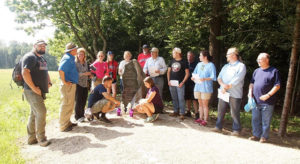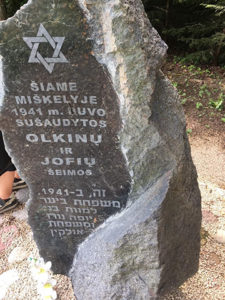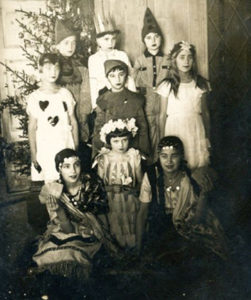A team from the University of Hartford travels to Lithuania to document the death – and life – of a young Jewish poet
By Judie Jacobson
Parts of this article are reprinted from “The Silenced Muse,” an essay by Laima Vince published in Deep Baltic, May 2018 (https://deepbaltic.com/2018/05/08/the-silenced-muse-the-life-of-a-murdered-jewish-lithuanian-poet/) , with additional information provided by Dr. Richard Freund.
It all started with a return trip to Lithuania.

Students and professors held a ceremony in memory of Matilda Olkin at a memorial erected near the site of the families’ murder. Her poetry was read in Lithuanian and English, and Kaddish was chanted in Hebrew, Lithuanian and English. Among those attending were (l to r) Sam Schneider, (University of Wisconsin-Eau Claire-UWEC), Prof Harry Jol (UWEC), Joan Silber (U.S. Commission for the Preservation of America’s Heritage Abroad), Abigail Dunkin (student, UHart), Dima Karakitukova, (student, UHart), Aldona Shapiro (U.S. sponsor), Prof Philip Reeder (Duquesne University), Prof Freund (Greenberg Center, UHart), Joseph Beck(UWEC), Madeline Fuerstenberg (UWEC), Chloe Kofman (UWEC), Giedrius Kujelis (Rokiskis Museum), Philip Shapiro (US sponsor). In front lighting candles: Justin Lockhart (UHart) and Taylor Ugrinow (UHart).
In early July, Dr. Richard Freund, director of the Maurice Greenberg Center for Judaic Studies at the University of Hartford, led a delegation of students and staff on a trip to Lithuania for the third season of excavations at the Great Synagogue of Vilna (Vilnius) and the Shulhoyf, the synagogue’s courtyard.
A renowned archaeologist, Freund and company joined a team of archaeologists and historians from Israel, Lithuania and the U.S. in uncovering – and re-discovering – the synagogue that was the epicenter of Jewish life in Vilna. Known as the “Jerusalem of Lithuania,” the vibrant city was at one time the intellectual, spiritual, and political capital of European Jewish civilization. One of the most important cities in Jewish history, Jews began settling in Vilna in the middle of the 15th century and 500 years later the city it was renowned as a center of Jewish religious life, Jewish education, Jewish politics, Jewish journalism, and the Jewish enlightenment.
This year’s excavation, led by Dr. Jon Seligman of the Israel Antiquities Authority, and Justinas Račas of the Kultūros paveldo Išsaugojimo pajėgos, focused on defining the outer walls of the bathhouse first exposed last year, and finding the back wall of the Great Synagogue. The work succeeded not only in pinpointing the massive external wall of the Great Synagogue and part of its floor, but also a part of the Bimah which was excavated below the floors of the school that was built over the Great Synagogue in the 1950s. Constructed in the 18th century, the ornate Bimah, was a two tiered Baroque structure with four Corinthian and eight Tuscan columns, pieces of which were found during the excavation.
“Without question, the discovery of the Bimah is an exciting development, as it was from this platform that the Torah was read to the Jewish community of Vilnius for three centuries before the building was burnt by the Nazis and later demolished by the Soviets,” say Seligman and Racas, who, in addition to Freund, were aided in their work by Zenonas Baubonis of Kultūros paveldo išsaugojimo pajėgos, Prof. Harry Jol of the University of Wisconsin, Eau Claire, and Prof. Philip Reeder of Duquesne University in Pennsylvania.
Giving voice to a young murdered poet
This summer, in addition to working on the on-going excavations of the Great Synagogue of Vilna, the University of Hartford research group was invited to do work in the region of Rokiskis, Lithuania, near the Latvian border. Among the projects that were suggested by the local municipality were a destroyed mikveh in Ponadel, a mass burial in the forest of Trakas, a manor house in Rokiskis, and a search for the mass burial of two families murdered in the early days of the Holocaust in Lithuania on the road from the village of Panemunėlis towards Kavoliškės.
Though all of their work represented fascinating journeys into the depths of history, it was the search for the mass burial site of the two murdered Jewish families – five members of the Olkin family and four members of the Jofe family – that captured with such great force the team’s emotions. Because, in uncovering the burial sites (with the use of Ground Penetrating Radar), Freund’s team also gave “life” – and preserved the literary legacy – of Matilda Olkin, an extraordinary young Jewish poet who was among the nine family members murdered by the Nazis in Panemunelis.
Freund brought with him Dr. Susan Cardillo, a professor in the University of Hartford’s School of Communications, who headed up a film crew tasked with the production of a documentary to be released later this year entitled “Finding Matilda: The Anne Frank of Lithuania.” The documentary represents the first collaboration between the U of Hartford’s Greenberg Center and School of Communications with Freund and the Greenberg Center’s Dr. Avinoam Patt, an expert in the history of the Holocaust. For Freund, who has previously been involved in the production of several films produced by NOVA, National Geographic, and the History Channel, this new “homegrown” documentary represents his first produced by the University of Hartford. Background for the film was also culled from the university’s Museum of Jewish Civilization’s permanent Holocaust collection, and the production involved students from various areas of study.
When his team learned of Matilda’s story, says Freund, “we were interested [in creating a documentary] – provided we could confirm the accounts and testimonies and give greater significance to Matilda’s work. It was amazing that there existed so much material from Lithuanian sources on the life, times and murder of one young Jewish woman in the Holocaust.”
Using one individual to convey the horrors of the Holocaust is both powerful and effective, says Freund. And not altogether unusual. Consider the story of Anne Frank.
“It is difficult to understand and teach about the extermination of six million largely anonymous Jews during the Holocaust,” he points out. “The story of Anne Frank helps the public and teachers talk about the Holocaust in particular, and tolerance and genocide in general. From the one, Anne Frank, the public and students can understand and humanize the many who were killed in the Holocaust.”
Indeed, Matilda Olkin’s story is at once heartbreaking and inspiring.
According to sources, her world ended on a warm and beautiful day in the summer of 1941, on the outskirts of the village of Panemunėlis. It was there that a group of local Lithuanians who were Nazi collaborators dug holes in the ground and then carted in a wagonload filled with nine members of two Jewish families – the Olkins and the Jofes – who lived and operated small businesses in the village of Panemunėlis.
Nauman Olkin was the local pharmacist. He was well known to the community for his kindness, often administering medicine to the sick free of charge. He was an intellectual who read Pushkin, Lermontov, and Dostoyevsky; and he was a close friend of the parish priest, Juozapas Matulionis. In that wagon also sat Olkin’s wife and three daughters, including 19-year-old daughter Matilda, who had been away in Vilna studying Russian and French literature. Matilda was well known in the region as a gifted poet – her compositions had been published in Lithuanian literary journals since she was 13.
The wagon stopped and the families were ordered to climb out. They were led at gunpoint to the crest of a hill where they were ordered to undress. According to a young eyewitness, who watched the horrific events unfold from behind a haystack, the screams and cries continued for a long time before the final gunshots came.
Matilda’s “life” was preserved when some of her writings were hidden by the local priest – her father’s good friend – in the midst of the Holocaust as one last act of compassion for a friendship between a Jewish and Catholic Lithuanian.
Ultimately, the team located the burial site of the two Jewish families.
“It is rare in geoscience and archaeology of the Holocaust to have eyewitnesses with exacting information that can direct our work to find an individual and a mass burial,” explains Freund. “In this case, we had an exact map indicating it was 70 meters (210 feet) in a very particular spot, and eight meters (24 feet, in the forest.) It is even rarer to have photographic evidence from the period of the crime scene (1944 flyovers by the Nazis) from the chaotic times of the Holocaust and that the area is still undeveloped and available for scientific investigation and that the local population and the government wants to know what is there.
“From Matilda’s childhood schools, to her enrollment in Vilnius University, to the hiding places of the family in 1941 and to the hiding place of the diary in St. Joseph’s Church in Panenmunelis, everyone wanted us to find Matilda.”
And so they did.
To bring closure to the search, the students gathered together at a roadside memorial to the victims that had been erected near the burial site they had located in the forest.
“We lit memorial candles, read Matilda’s poems in English and Lithuanian, together with our Lithuanian archaeologist and local Lithuanian historian and in the presence of Dr. Joan Silber, a member of the U.S. Commission for America’s Heritage Abroad who was one of our sponsors, who flew in from the USA, working together with us. A specially translated Lithuanian Jewish prayer for the Holocaust victims was said,” says Freund.
“I was very moved by the efforts of college students working in the field and using science to find a Jewish poetess and track her life from her small Lithuanian village of Panemunelis to her college at the University of Vilnius to her killing and burial on the road in 1941. They investigated the clues of her life in her home town, her schools, her house, including the hiding sites for the family and her diary. I am extremely inspired by what our students accomplished.”
Ultimately, says Freund, “it was Matilda’s diary that spoke to many of our students and the teenagers of Lithuania. Her diary and the writings did not lead us to the location of the burial site on a deserted road in Lithuania but her poems, which speak with a prophetic voice, did. It is her words that make the Holocaust ‘real’ for our students and the public. We used 1944 photographic comparisons and comparative geoscience of other Holocaust mass burials in the area and the comparison of eyewitness accounts. But in the end it took a close reading of her writings to ‘Find Matilda.’”
“We searched for Matilda’s ‘footprints in the sand’ and by understanding Anne Frank we understand Matilda and by understanding Matilda, I think, we also understand more about Anne Frank.”
Death of a Poet
A gifted poet, Matilda Olkin’s compositions were published in Lithuanian literary journals since she was the age of 13. In her slender notebook of handwritten poems, which was found decades later, there is a poem that foretold the awful day she was murdered.
The following is an English translation of Matilda Olkin’s poem by Laima VInce.
My People
A pair of dark eyes ignite once again
With a pain that could not be extinguished or laid to rest.
And they—they just keep walking past and away.
But for me, Lord, there are no words.
Do you hear? Do hear that awful laughter?
The hills, even the hills shake with it—
And the rivers will faint, and the seas will faint—
And the stone will cry, the stone will cry.
You are laughing? You walk past and keep on walking,
But for me, Lord, there are no words for my horror.
That laughter—that awful laughter… And dark eyes flash
With an undying, relentless pain.







 Southern New England Jewish Ledger
Southern New England Jewish Ledger
















